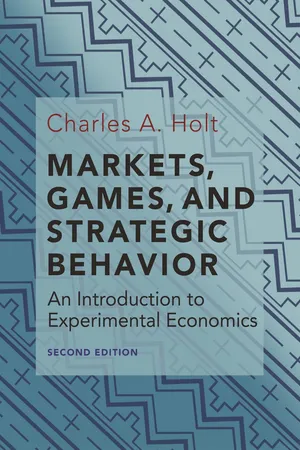
Markets, Games, and Strategic Behavior
An Introduction to Experimental Economics (Second Edition)
- English
- PDF
- Available on iOS & Android
Markets, Games, and Strategic Behavior
An Introduction to Experimental Economics (Second Edition)
About this book
From a pioneer in experimental economics, an expanded and updated edition of a textbook that brings economic experiments into the classroom
Economics is rapidly becoming a more experimental science, and the best way to convey insights from this research is to engage students in classroom simulations that motivate subsequent discussions and reading. In this expanded and updated second edition of Markets, Games, and Strategic Behavior, Charles Holt, one of the leaders in experimental economics, provides an unparalleled introduction to the study of economic behavior, organized around risky decisions, games of strategy, and economic markets that can be simulated in class. Each chapter is based on a key experiment, presented with accessible examples and just enough theory.
Featuring innovative applications from the lab and the field, the book introduces new research on a wide range of topics. Core chapters provide an introduction to the experimental analysis of markets and strategic decisions made in the shadow of risk or conflict. Instructors can then pick and choose among topics focused on bargaining, game theory, social preferences, industrial organization, public choice and voting, asset market bubbles, and auctions.
Based on decades of teaching experience, this is the perfect book for any undergraduate course in experimental economics or behavioral game theory.
- New material on topics such as matching, belief elicitation, repeated games, prospect theory, probabilistic choice, macro experiments, and statistical analysis
- Participatory experiments that connect behavioral theory and laboratory research
- Largely self-contained chapters that can each be covered in a single class
- Guidance for instructors on setting up classroom experiments, with either hand-run procedures or free online software
- End-of-chapter problems, including some conceptual-design questions, with hints or partial solutions provided
Frequently asked questions
- Essential is ideal for learners and professionals who enjoy exploring a wide range of subjects. Access the Essential Library with 800,000+ trusted titles and best-sellers across business, personal growth, and the humanities. Includes unlimited reading time and Standard Read Aloud voice.
- Complete: Perfect for advanced learners and researchers needing full, unrestricted access. Unlock 1.4M+ books across hundreds of subjects, including academic and specialized titles. The Complete Plan also includes advanced features like Premium Read Aloud and Research Assistant.
Please note we cannot support devices running on iOS 13 and Android 7 or earlier. Learn more about using the app.
Information

Table of contents
- Cover
- Title
- Copyright
- Dedication
- Contents
- Preface
- 1 Introduction
- 2 Price Discovery and Exclusion
- I INDIVIDUAL DECISIONS: RISK AVERSION, PROSPECT THEORY, AND LEARNING
- II BEHAVIORAL GAME THEORY
- III SOCIAL PREFERENCES
- IV MARKET EXPERIMENTS
- V AUCTIONS AND MECHANISM DESIGN
- Appendix 1: Hints for End-of-Chapter Problems
- References
- Appendix 2: Instructions for Class Experiments
- Index